

Ten facts about the Vikings. Fun Facts on Vikings for kids *** Fun Facts on Vikings for KidsLooking for help with homework and school?
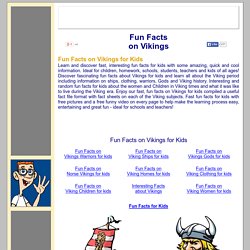
Find out fast, fun facts and interesting information using our useful fact files, fact sheets and funny videos on each of the Viking Subjects. The free Facts Files and Fact sheets provide interesting, amazing, fun facts and information, together with pictures, photos and a fun video. The free fact files and free fact sheets include cool info plus a free video, they are great guide to the Viking Era and include topics about warriors, ships, women, children, history, clothing and daily home life Fun Facts on Vikings Ships for KidsFind out quick, fun facts and interesting information using our useful fact files and fact sheets on Viking Ships. The Vikings and the Saxons kids. Norse Mythology 5 Gods of Asgard. The Vikings Video - Vikings. The Viking Village. Unity 5 Demo Scene: Viking Village. Vikings Homework Help. Where did the Vikings settle in Britain?
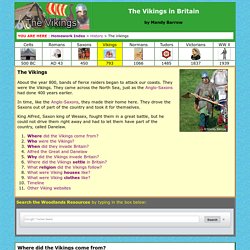
The area eventually settled by Vikings was called the Danelaw. It formed a boundary separating Anglo-Saxon England from Viking England and was defined in a treaty between the English King Alfred and Viking King Guthrum in AD 880. It lay north of Watling Street, a Roman road running from London north-west to Chester and covered northern and eastern England. It included counties north of an imaginary line running from London to Bedford and then up to Chester.
Viking Myths reading comprehension. Longhouse. A longhouse or long house is a type of long, proportionately narrow, single-room building built by peoples in various parts of the world including Asia, Europe and North America.
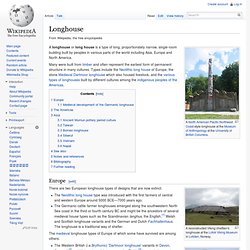
Many were built from timber and often represent the earliest form of permanent structure in many cultures. Types include the Neolithic long house of Europe, the stone Medieval Dartmoor longhouse which also housed livestock, and the various types of longhouses built by different cultures among the indigenous peoples of the Americas. Europe[edit] There are two European longhouse types of designs that are now extinct.
The medieval longhouse types of Europe of which some have survived are among others: Dartmoor granite longhouse Medieval development of the Germanic longhouse[edit] The Americas[edit] In South America, the Tucano people of Colombia and northwest Brazil traditionally combine a household in a single long house. Asia[edit] Ancient Mumun pottery period culture[edit] Taiwan[edit] Mead hall. A reconstructed Viking Age longhouse (28.5 metres long). In ancient Scandinavia and Germanic Europe a mead hall or feasting hall was initially simply a large building with a single room. From the fifth century to early medieval times such a building was the residence of a lord and his retainers.
The mead hall was generally the great hall of the king. As such, it was likely to be the safest place in the kingdom. Etymology[edit] The old name of such halls may have been sal/salr and thus be present in old place names such as "Uppsala".[1] The meaning has been preserved in German Saal, Romanian Sala, Dutch zaal, Icelandic salur, Swedish sal, Finnish sali, French salle and Italian sala (all meaning "hall" or "large room"). Archaeology[edit] From around AD 500 up until the Christianization of Scandinavia (by the 13th century), these large halls were vital parts of the political center.
Examples that have been excavated include: History: Vikings. V I K I N G S : T H E N O R T H A T L A N T I C S A G A. Viking Axe - Cold Steel Knives. Specifications: Overall Length: 52" Hawk Length: 9 5/8" Primary Edge: 10 1/3" Steel: 1055 Carbon Weight: 4 Lbs. 10 oz Handle: 48" Long.
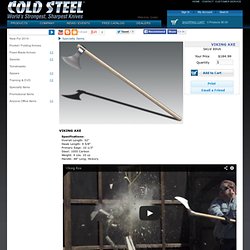
Hickory Viking Axe Cold Steel has been a long time believer in the ferocious cutting power of a well-designed Viking Axe. Until recently, we lacked the technical ability to make one to our satisfaction. However, with our new state-of-the-art forging facility, we can offer our customers something truly exceptional. Our Viking Axe's formidably long, thin blade is fully polished and hand sharpened to a bone-splitting, shield shattering edge.
Vikings: Secrets of the Vikings: Shield Maidens. Norse Clip Art. Viking History. What Vikings really looked like. The fine decoration of the Oseberg ship in Norway, which was buried in the year 834, provides clues to what Vikings looked like.
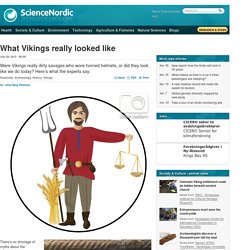
Inside the ship were two women and the archaeologists believe the ship has served as a sarcophagus. (Photo: Annie Dalbéra) There’s no shortage of myths about the appearance of our notorious Viking ancestors. To find out more about these myths, ScienceNordic’s Danish partner site, videnskab.dk, asked its Facebook readers to list their favourite myths about what the Vikings looked like. We have picked out five myths from the resulting debate and asked researchers to help us confirm or bust these myths. Armed with this information, our graphic designer then took a shot at drawing some examples of our infamous forefathers, which you can see in our picture gallery.